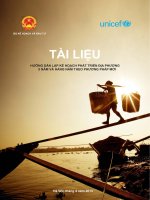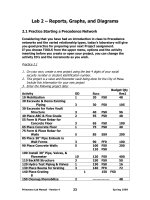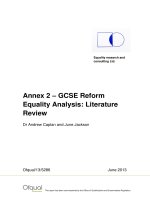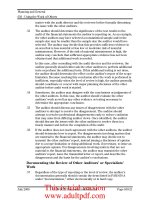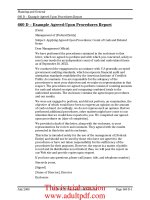SHF OPERATIONAL MANUAL: ANNEX 2 BUDGET GUIDANCE FINANCIAL AND PROCUREMENT GUIDELINES (15 FEBRUARY 2021)
Bạn đang xem bản rút gọn của tài liệu. Xem và tải ngay bản đầy đủ của tài liệu tại đây (763.92 KB, 34 trang )
<span class="text_page_counter">Trang 1</span><div class="page_container" data-page="1">
This document consists of four sections:
<b>(a) Budget guidance </b>
<b>(b) Guidance note on preparation of budget breakdowns (c) SHF financial and procurement guidelines </b>
<b>(d) Shared costs </b>
<b>(e) Asset inventory management </b>
<b>Basic Definitions and Guidance on the Project Budget Preparation Process </b>
1. The objective of this section is to provide partners, OCHA Country Offices, HFUs and OCHA headquarters with a common framework to facilitate the appropriate preparation, review and clearance of project budgets. This guidance focuses on defining eligible and ineligible costs, direct and indirect costs (e.g. Programme Support Costs – PSC), shared costs, budget categories and the adequate break-down of budget lines.
2. This guidance applies to UN agencies including IOM and NGOs.
<b>Rationale and Basic Principles of the Project Budget </b>
3. A clear segregation of duties underpins the preparation, review and clearance of the project budget. This is critical to preserve the country-driven nature of CBPFs and necessary to ensure central and internal controls to reduce the risk of approving erroneous or inappropriate project budgets (e.g. miscalculations, inconsistency, and lack of transparency or admission of ineligible costs). In this regard, fund managers in the field, certifying finance officers at headquarters, and implementing partners have specific roles and responsibilities, as follows: 4. Fund managers are responsible to ensure that:
I. The principles of economy, efficiency, effectiveness, transparency and accountability are adhered to in the sense that the project budget inputs are commensurate with the planned activities and the expected outputs, more specifically, that the project budget is a correct, fair and reasonable reflection of the project proposal/logical framework.
II. The cost estimates are reasonable in the specific country context so that funding will be used in the most efficient way.
5. The role of certifying finance officers in headquarters is to:
<b>SHF Operational Manual: Annex 2 </b>
<b>Budget Guidance & Financial and Procurement Guidelines</b>
(15 February 2021)
</div><span class="text_page_counter">Trang 2</span><div class="page_container" data-page="2">I. Verify the budget’s factual correctness, checking coherence with the project proposal and logical framework.
II. Flag concerns and seek clarification from fund managers on issues that may compromise compliance with UN rules and affect financial transparency and accountability.
6. The role of implementing partners in the budgeting process is to:
I. Provide a correct and fair budget breakdown of the planned costs that are necessary to implement the activities and achieve the objectives of the project.
II. Use and comply with the budget template on GMS and guidance provided by OCHA for the classification and itemization of planned costs.
III. Provide a budget narrative (as an essential component of the budget) that clearly explains the object and the rationale of any budget line. For example, shared costs, large/expensive assets, and costs/equipment required to support the regular operation of the implementing partner, are clear cases where the provision of details will be necessary in the budget narrative.
<b>Eligible and ineligible costs </b>
<i><b>Eligible Costs </b></i>
7. The following attributes define nature of eligible costs.
• Must be necessary and reasonable for the delivery of the objectives of the project.
• Must comply with the principles of sound financial management, in particular the principles of economy, efficiency, effectiveness, transparency and accountability.
• Must be identifiable in the accounting records and backed by original supporting evidence as incurred in accordance with the approved project proposal and period.
• Must be included in project budget.
• Must be incurred in accordance with approved project proposal. • Must be incurred within the project period.
8. These may include
• <b>Staff Costs- including salaries, social security contributions, medical insurance, and hazard </b>
pay for high-risk locations) involved in the management and implementation of the project. Salaries and costs may not exceed the costs normally borne by the IP in other projects.
• <b>Consultancies included in the project implementation. </b>
• <b>Support staff costs at country level directly related to the project may be partly included. </b>
• <b>Travel and subsistence costs directly linked to the project implementation for project staff, </b>
consultants, and other personnel that may also be eligible, provided the costs do not exceed those normally borne by the IP. Subsistence costs for government officials when they are part of monitoring missions for activities which are not considered to be part of their duties (which would be covered in their salaries) are eligible. Such costs should be supported by monitoring reports submitted and signed by government officials that participated in the monitoring and should include contact details. Partners, who are responsible for payment, should include such costs in their budget proposals to be considered for approval. Subsistence allowance paid for activities such as participation in coordination, engagement of partners and overseeing
</div><span class="text_page_counter">Trang 3</span><div class="page_container" data-page="3">distribution of project items are not eligible. The costs do not exceed those normally borne by the IP.
• <b>Shared costs: well-justified request and reasonable allocation system. Must be itemized. See </b>
also annex 2(d).
• <b>Financial support to beneficiaries e.g. cash and voucher-based distribution. </b>
• <b>Purchase costs for goods and services to the project to the beneficiaries of the project, </b>
including quality control, transport, storage and distribution costs.
• <b>Non-expendable items (assets) e.g. IT equipment for registration, medical equipment, water </b>
pumps and generators, etc.
• <b>Expenditure related to the award of contracts e.g. costs for the tendering process. </b>
• <b>Sub-implementing partner’s costs- directly attributable project implementation. </b>
• <b>Others- monitoring, reporting, and evaluation, dissemination of information, translation, and </b>
insurance, financial service costs (in particular, bank fees for transfers).
<i><b>Ineligible Costs </b></i>
9. Ineligible costs are broadly
• Costs not included in approved budget;
• Costs incurred outside approved project implementation period; • Expenditures over and above the approved total budget;
• Costs that do not have supporting documentation;
• Costs that are not covered by the SHF-budgetary guideline.
10. Other ineligible costs include
• Debts and provisions for possible future losses or debts. • Interest owed by the IP to any third party.
• Items already financed from other sources. • Purchases of land or buildings.
• Currency exchange losses.
• Cessions and rebates by the IP, contractors or staff of the IP of part of declared costs for the project.
• Government staff salaries.
• Hospitality expenses, provision of food/refreshments for project staff (not including water and hospitality for trainings, events and meeting directly related to project implementation).
• Incentives, mark-ups, gifts to staff.
• Fringe benefits such as cars provided by the organization to staff, individual full housing allowance and the like.
• Fines and penalties.
• Duties, charges, taxes (including VAT) recoverable by the IP. • Global evaluation of programmers.
• Audit fees/system audit fees – these costs are paid directly by the fund
<b>Insufficient supporting documents </b>
11. Expenditures may be classified as insufficiently supported for the following among other reasons:
</div><span class="text_page_counter">Trang 4</span><div class="page_container" data-page="4">• Lack of third-party documentation such as original invoice or unavailability of signed receipt acknowledgment (such as in the case of a training per diem).
• Lack of evidence of receipt of goods or performance of services. This includes goods received notes for water trucking, school feeding programme, food & NFI vouchers and beneficiary lists. • Absence of justification for vehicle hire (especially in the presence of conflicting odometer
readings or expected programmatic scope).
• Lack of boarding passes/hotel invoices to support travel claims.
• Lack of supporting documentation for supplies and suppliers evidencing the existence of goods or services (inventory, receipt, invoices and proof of payment, as the case may be).
• Lack of signature of employee on employment contract.
• Absence of signature on per diem claims and attendance sheets, or duplications / inconsistencies in the signature sheets.
• Insufficient number of authorized signatures for the amounts claimed
• Payment was made to an individual, but the supporting invoice was provided by a company / business.
• Cheques endorsed and cashed by a principal recipient-associated individual without appropriate justification.
• Lack of documentation to support expenditures (i.e. only cash register receipts or bank statement entries, no other accounting records).
• Absence of original tender documentation.
• Insufficient evidence of request for quotes or quotations received.
• Shared costs not appropriately justified (see annex 2(d) for detailed guidance).
<b>Other Types of Costs </b>
12. On a case-by-case basis and depending on the objectives of the fund, the fund manager retains the flexibility to consider the following costs as eligible:
• Government staff training as a component of a project activity that contributes to the achievement of the overall project objectives.
• Seconded qualified staff by the Government to support the project implementation i.e. health staff and teachers paid incentives
• Visibility material of the IP directly related to projects funded by Somalia Humanitarian Fund. • International travel costs when directly linked to the delivery of the project objectives. When
international travel costs are requested to support additional activities outside those of the project, such costs can only be considered if they are well justified and, in the proportion, attributable to the project.
• Vehicles.
• Depreciation costs for non-expendable/durable equipment used for the project for which the cost is not funded in the current budget or prior CBPF funding.
• Equipment for the regular operations of the IP. • Recurrent costs for the IP’s current operations.
<b>Direct Costs </b>
13. Direct costs have to be clearly linked to the project activities described in the project proposal and the logical framework. They are defined as actual costs directly related to the implementation of the project to cover the costs of goods and services delivered to beneficiaries, and the costs related
</div><span class="text_page_counter">Trang 5</span><div class="page_container" data-page="5">to the support activities (even partial, such as a security guard or a logistician partially working for the project), required for the delivery of services and the achievement of the project objectives. 14. Direct costs include
• <b>Staff and related personnel costs, including consultants and other personnel. </b>
• <b>Supplies, commodities, materials. </b>
• <b>Equipment. </b>
• <b>Contractual services. </b>
• <b>Travel costs, including transportation, fuel, and daily subsistence allowances for staff, </b>
consultants and other personnel linked to the project. • <b>Transfers and grants to counterparts. </b>
• <b>General operating costs, security expenses, office stationary/supplies, utilities </b>
(telecommunications, internet, water, electricity, office rent). • <b>Other direct costs e.g. monitoring, evaluation and reporting. Indirect Costs </b>
15. Indirect costs are also called Programme Support Costs (PSC).
• PSC are all costs that are incurred by the IP regardless of scope and level of its activities and which cannot be traced unequivocally to specific activities. Examples – corporate costs (headquarters costs, legal services, general procurement, recruitment, etc.) not related to a particular project.
• PSC is maximum 7 per cent of the approved direct expenditures.
• PSC of sub-IPs associated to the implementation of a specific project should be covered by the overall maximum 7 per cent of the actual project expenditures.
• Indirect costs do not have to be itemization in the project budget.
<b>Shared Costs </b>
16. Sharing costs between different donors and projects under a country programme of an IP is an acceptable practice for CBPFs. The IP may share certain Country Office costs to different uses and projects, for example staff, office rent, utilities and rented vehicles.
17. The following guidance shall be observed when including shared costs in the project budget: • Shared costs must be directly linked to project.
• Itemized in budget, following standard accounting practice and based on a well-justified, reasonable and fair allocation system, to be clearly explained in the budget narrative of the project and to be assessed and approved by the OCHA/HFU in the OCHA Country Office. • The IP should at any time be able to demonstrate how the costs were derived and explain in
the project proposal/logical framework how the calculation has been made (e.g. pro-rata, averages).
• For staff-related costs, if a position is cost-shared, the percentage of the monthly cost corresponding to the time that the person will dedicate to the project shall be budgeted. It is not acceptable to have portions of a unit for staff costs, only percentages are acceptable.
• Non-staff shared costs should be shared on the basis of an equitable cost allocation system. Accordingly, the percentages in the budget are to be assessed and approved by the OCHA/HFU in the OCHA Country Office.
</div><span class="text_page_counter">Trang 6</span><div class="page_container" data-page="6"><b>Itemization of Budget Lines </b>
18. A project budget must be credible and in line with sound financial management principles. It should describe what the project proposes to do in financial terms and values. The budget review process will ensure that budgeted costs are correct, fair and a reasonable reflection of what is needed to carry out the project. Concerns in relation to compliance with UN rules and regulations and financial accountability must be addressed before projects will be approved.
19. The project budget is classified in seven categories: 1. Staff and other personnel costs
2. Supplies, commodities, materials (project inputs) 3. Equipment
4. Contractual Services 5. Travel
6. Transfer and Grants to counterparts 7. General Operating and Other Direct costs
In addition, not more than 7 per cent project support cost (PSC).
<b>1. Staff and Other Personnel Costs </b>
These are costs and entitlements of national and international staff involved in the management and implementation of the project contracted directly by the hiring organization.
<b>a. Direct staff cost </b>
These are salaries and entitlements for staff working directly on the project e.g. (Programme personnel like health officers, WASH engineers etc.)
<b>b. Support Staff </b>
These are salaries and entitlements of staff engaged in management, support and administrative activities e.g. (Country Director, Executive, Grants Officer, Finance Coordinator, Human Resource Manager, Logistics Officer)
<i><b>Budget itemization of personnel costs </b></i>
• Each position should be in a separate budget line and roles and responsibilities clearly stated. Note the maximum budget line is 20, more positions should be lumped up in one budget line and a breakdown provided in excel and their roles and responsibilities clearly stated.
• The unit quantity should be a whole number. • Salary should cut across the whole project period.
• The amounts and percentages indicated in the remark section to be consistent with the budget • No overlaps and insert “D” for direct staff and “S” for support staff
• Cost shared positions, budget the portion of their monthly costs that will be dedicated to SHF
</div><span class="text_page_counter">Trang 7</span><div class="page_container" data-page="7">• No overlaps or duplication of roles and responsibilities • Acronyms must be spelled out
• Positions under budget description should be as per the Organogram or TOR.
• Staff and personnel costs should be consistent with the mandatory staff lists provided by the partner. Partners should report any changes in staffing through submission of updated staff lists and requests for approval. Changes should not affect total amounts for the staff and personnel budget category.
<b>2. Supplies Commodities and Materials </b>
These are costs related to the project activities;
• Procurement of consumables or supplies for project implementation i.e. medical supplies, learning materials, nutrition supplies, food supplies, NFI, tools, tents, furniture, kits)
• Construction/ Rehabilitation Works; construction of temporary learning spaces, rehabilitation of boreholes, Construction of toilets
• Cash for work or Unconditional cash transfers • Food vouchers
• Transportation of supplies through road or air transportation.
• Warehouse rent used for storage of supplies procured for project implementation
• Training conducted to project staff and community members or beneficiaries for the project i.e. community health workers, hygiene promoters, caregivers, teachers
• Communication materials used to raise awareness and project visibility
• Incentives for seconded staff by the ministry or government to support the project i.e. teachers, nurses, auxiliary nurses. These are staff not in the organization payroll
<i><b>Budget itemization of supply commodities </b></i>
• Number of participants, beneficiaries who will benefit from the supplies or trainings or construction should be provided in the remark section
• The unit quantity, unit cost and duration should be clearly presented in the budget (tons, liters, kgs, trips, days, months, boxes)
• Unit cost should be in two decimal points only
• <b>Option 1 – Water distribution for the project to be clearly presented in the budget; Total number </b>
of liters of water to be provided as unit quantity e.g. (total number of beneficiaries x number of liters per beneficiary) and unit cost (should be within the standard market rate and to be confirmed by the cluster) and duration.
• <b>Option 2 – Water supply can be presented as unit quantity per truck (liters) and unit cost (as </b>
per standard market rate confirmed by cluster) and duration.
• A detailed breakdown to be provided for all procured supplies in a bill of quantity/budget breakdown.
• Freight and transport costs to be clearly broken down -weight of the supplies (kg, tonnage), size of the truck and number of trips or duration to be provided.
• Standard kits (pep kit, Interagency Emergency Health Kits) above USD 4000, the contents and cost for each item to be provided in a detailed breakdown and kits below USD4000 items to be provided however a detailed breakdown of the costs not to be provided
</div><span class="text_page_counter">Trang 8</span><div class="page_container" data-page="8">• In the case of construction works above $4000, only the known labor costs and essential materials shall be budgeted and itemized (unit, number of units and unit cost). The description should explain how the costs have been estimated on the basis of a standard prototype of construction (e.g. latrine, health post, shelter), type of materials (e.g. wood, prefabricated, concrete), and the formula or rationale used to make the calculation (e.g. per square foot or square meter, based on previous experience etc.).
• Costs for facilitators, venue, refreshments and stationeries are consistent for all funded projects • Costs should be within the standard market rate for warehouse, water per liter, water per truck,
water per barrel etc.
• Food and cash memo to be fully signed and stamped attached
• The total in the budget should be consistent to the BOQ/budget breakdown • Spell out all acronyms
<b>3. Equipment </b>
Procurement of tools for the benefit of the project implementation; • IT equipment- Laptop, desktop
• Medical Equipment- Fridge, Delivery Beds, Stethoscope, Weighing scale, ECG • Water Equipment- Water pump, Generators
<i><b>Budget Itemization of Equipment </b></i>
• Technical specification for items to be provided- IT, ECG equipment to be provided in the BOQ
• Contract for consulting services
<i><b>Budget Itemization of contractual services </b></i>
• Contract between organization and the service to be provided • A detailed breakdown of the cost to be provided
• The description field must be used to provide details of the nature of the contract and its intended outputs, showing how these are relevant to, and necessary for, project implementation. The description may refer to the project log frame or activity plan as appropriate in order to clarify the rationale and justification for the contract.
<b>5. Travel </b>
</div><span class="text_page_counter">Trang 9</span><div class="page_container" data-page="9">Travel costs of staff, consultant and other project personnel. This includes • Daily subsistence
• Local flights • Hazard pay, • Travel entitlements
• Fuel and vehicle rental for staff
<i><b>Budget Itemization of contractual services </b></i>
• Itemize international and national travel and position of the traveler.
• Project staff, consultant and other personnel travel- details of the number of days, DSA, national and international flight costs (round/single trip), accommodation cost, vehicle rental transfers, SPU security service charges
<i>• The costs for travel and per diem should be within the market rates </i>
<b>6. Transfers and Grants to Counterparts </b>
Entities receiving sub-grants could be NGOs
<i><b>Budget Itemization of Transfer and grants to counterparts </b></i>
• Each cost should be presented in each budget line and the costs well presented
• The name of the organization receiving the fund should be indicated in each budget line description
• A detailed breakdown of the costs to be provided in BOQ for supplies, travel, operational costs etc.
• All acronyms to be spelled out
• The total budget under category 6 should be consistent to that in the cover page • The budget guidance is applied same as all categories
<b>7. General Operating Costs </b>
They are costs directly linked to the project implementation. The cost includes; office running costs, office rent, utilities, security services costs, bank charges, office stationeries, communication costs for the project implementation.
<i><b>Budget Itemization of general operating costs </b></i>
• Where cost sharing arrangements are in place and the cost of any budgeted item is not fully charged to the project (i.e. where the item is paid for partially by the SHF and partially from other funding sources), it is preferable that the item is budgeted throughout the full project period. Where a different period is used for the budget calculation a clear explanation / justification should be provided in the description field. This applies equally to staff costs and other non-staff costs such as rentals, utilities etc.
• The offices should be indicated in the budget description.
</div><span class="text_page_counter">Trang 10</span><div class="page_container" data-page="10">• Shared costs should be clearly broken down for more than one office in a BOQ and it should be spread through the whole project period.
• For office supplies, the quantities and unit costs should be reasonable.
• Under general operating costs, the budget should not be presented as a lump sum apart from bank fees.
• Provide the percentage for transfer charges in the remark section for hawala. • The total budget in the BOQ should be consistent to the budget.
<b>Project Support Cost (PSC) is charged as a maximum of 7 per cent of the approved direct project </b>
budget or incurred cost by the implementing partner.
</div><span class="text_page_counter">Trang 11</span><div class="page_container" data-page="11"><b>Annex 2 (b) Guidance note on preparation of budget breakdowns</b>
<b>1. Staff and Other Personnel (Please itemize costs of staff, consultants and other personnel recruited by implementing partner for project implementation) </b>
<b>Education Project Officer: The Education Project Officer role includes: Project monitoring and </b>
supervision, assisting field teams in achieving the project deliverable. He is responsible for the day to day activities of the project and tracking of the project indicators. He is to prepare the project field reports and submit to the Programs Coordinator. The Education Project Officer is to receive all community concerns and ensures there is full accountability to the project beneficiaries. He is to dedicate 100% of his time to the project. He ensures the runs according the agreed work plan.
<b>Finance Officer: The finance officer will be responsible for all financial and procurement matters of the </b>
project. He will ensure the preparation timely submission of project financial reports to the donor. The will guide the project on all issues with regards to project finances as part of his role in project budget tracking. He shall dedicate 30% of his time to the project.
</div><span class="text_page_counter">Trang 12</span><div class="page_container" data-page="12"><b>2. Supplies, commodities and materials (consumables to be purchased under the project, including associated transportation, freight, storage and distribution costs; Construction works, and trainings) </b>
<b>A) CONSTRUCTION AND REHABILITATION </b>
<i><b>Sample 1 (Temporary learning spaces) </b></i>
This is the cost of constructing 10 temporary classrooms for the six schools (2 classrooms per school) at the unit cost of $2,502.20 per class room. The overall cost is $ 25,022.00. This will improve access to education by enrolling children out of school and retaining those in school. SHF will cover 100% of the cost. BOQ attached
<b>BOQ </b>
2.1. Construction of temporary classrooms
quantity <sup>Unit Cost Units </sup> <sup>Units </sup> <sup>CHF </sup>contribution % <sup>Total </sup> Cleaning the construction site (7x6) <sub>42 </sub> <sub>1.2 </sub> <sub>m </sub> <sub>m </sub> <sub>100% </sub> <sub>50.4 </sub> Fixing Wooden posts (80X40X4000) mm into
ground 35cm deep with cement sand and gravel
at the space of 1.2m and height of 4m <sup>18 </sup> <sup>8 </sup> <sup>pcs </sup> <sup>pcs </sup> <sup>100% </sup> <sup>144 </sup> Complete Roof, King post truss( 80x40)mm,
Purlin (25x50)mm Guage 30 CGI iron sheet for
roof and walling (800x2400)mm <sup>98 </sup> <sup>18 </sup> <sup>m2 </sup> <sup>m2 </sup> <sup>100% </sup> <sup>1764 </sup> Door made of fabricate CGI Framed
wooden(900x2000)mm completed in all aspect
Windows made of Fabricated CGI and wooden
(1000x800)mm completed in all aspects <sup>2 </sup> <sup>12 </sup> <sup>pcs </sup> <sup>pcs </sup> <sup>100% </sup> <sup>24 </sup> Provide 15cm thick plain concrete around
perimeter of the class both inside and outside to
hold the structure firm on ground. <sup>40 </sup> <sup>10 </sup> <sup>m </sup> <sup>m </sup> <sup>100% </sup> <sup>400 </sup> Painting all CGI with red oxide paint with SCI
</div><span class="text_page_counter">Trang 13</span><div class="page_container" data-page="13"><i><b>Sample 2 (Rehabilitation of boreholes) </b></i>
As per the need assessment conducted in the target areas, 2 Boreholes strategic water sources were identified for rehabilitation as exist strategy after trucking, (01 in Owdwayne and one in Laasqorey District). The allocated cost will cater the most urgent needs as per the recent technical assessment. Further details see BOQs annexed. The total cost for rehabilitation is $ 22,605.00
<b>BOQ </b>
2.2 Rehabilitation of 2 Boreholes ( Odweyne and Habarshiro) A. Odweyne District Borehole Rehabilitation
S.# Descriptions of work/activities Unit Quantity Unit Cost
(USD) <sup>Total Cost (USD) </sup> 1 Supply and Install Solar Panels of Mono Crystalline Type No. 32 PCs
which is 300W in a 72 cell VOC 44.5V VMP 35.8V <sup>32 </sup> <sup>PCs </sup> <sup>$300.00 </sup> <sup>$9,600.00 </sup> 2 Case Water Proof for Solar pump inverter Inverter 22KW Controller/
pump Inverter Input DC & AC Output 380VAC 3Phase 50Hz.; <sup>1 </sup> <sup>PCs </sup> <sup>$30.00 </sup> <sup>$30.00 </sup> 3 PV Disconnect Switch 440VDC/40A 1 PCs $60.00 $60.00 4 Well Probe Sensor and Water Tank sensor. 2 PCs $30.00 $60.00
7 Combiner fuse box & small accessory; DC Combiner Fuse box; DC
circuit breaker; Manual transfer switch-generator & PV Array. <sup>1 </sup> <sup>LMS </sup> <sup>$50.00 </sup> <sup>$50.00 </sup> 8 Cable 16mm x 4 core PVC insulated 120 M 120 M $6.00 $720.00 9 Supply and Install the Solar Support mounting structure steel frame
with Gentel sloping of 2m Elevation with the guidance of technical team ,welding, framework, man powering, painting, laboring for all the No. 32 PCs of the Solar Pannels and fixing in to the ground floor.
32 PCs $4.00 $128.00
12 Installation, internal wiring sundries, sensors. 1 LMS $300.00 $300.00 13 Material Transportation to the destination 1 LMS $200.00 $200.00
C.Habarshiro borehole rehabilitation Abstract of Quantities and cost (BOQ) for Habarshiro borehole rehabilitation
S.No. Description of activities/work Unit Quantity Unit Cost
(USD) <sup>Total Cost (USD) </sup> 1.1 Providing and fixing Installation of new generator set of 30 kva with 3
cylinders, made by Perkins (30KVA, UK, PERKINS) and complete with all its fittings and all aspects, Perkins 1103A-33G, 3 cylinder, 3.3ltr, DSE3110 Key/Auto Start Module, DSE4620 AMF Module as option.,
No. 1
9,800.00 9,800.00 <sup> </sup>
</div><span class="text_page_counter">Trang 14</span><div class="page_container" data-page="14">Frequency 50hz/60 hz, Phase - 3 phase, prome power -30kva/24kw, standby power-33kva/26kw
1.2 Transportation of the Generator from spare part ( Selling point) to
Borehole site. In this case Bosaso to Habarshiro and fixation <sup>No. </sup> <sup>1 </sup> 312.00 <sup> </sup> 312.00 <sup> </sup>
500 Laborer will be provided with tools. (Axe Wheelbarrow, big axe, Shovel, forks hand gloves) to rehabilitated community assets infrastructure in 5 target villages -BOQ attached
<b> Descriptions of work/activities Units Quantity Unit Rate ($) Amount ($) </b>
200 HHs of Unconditional cash transfer will be supported for the most vulnerable groups of the community including widows, women head HH, families with disabilities or with severe prolonged illness and isolated families without external support. The supporting period will be 3 month and the rate is 85%
</div><span class="text_page_counter">Trang 15</span><div class="page_container" data-page="15">of Minimum Expenditure Basket (MEB) which corresponding 85 USD. 100% of the 85% of the MEB will be charged to SHF.
<b>BOQ </b>
<b> Descriptions of work/activities Quantity Unit Unit Rate ($) Duration </b>
Drugs and other medical supplies will be purchased for use in 3 static health facilities in Mahadaay, Balcad and Hawadley and the 2 mobile clinics to deliver emergency life-saving health services to drought affected population in Middle Shebelle. See the BoQ of the items to be purchased.
2.5 Medical and Non-
medical supplies <b>Exchange Rate Usd = Kes. 102.48 </b>
<b>Descritption Units Quantity <sup>Unit Price </sup><sub>(Kes) </sub>Totakl (Kes) <sub>Consumption/Month </sub><sup>Total in USD </sup></b>
</div><span class="text_page_counter">Trang 16</span><div class="page_container" data-page="16">Ferro sulphate packs <sub>4 877.00 </sub> <sup> </sup><sub>3,508.00 </sub> <sub>34.23 </sub> <sub>308.08 </sub><sup> </sup>
Gentian Violet packs <sub>3 339.00 </sub> <sup> </sup><sub>1,017.00 </sub> <sub>9.92 </sub> <sub>89.31 </sub><sup> </sup>
Prednisolone tablet boxes <sub>6 122.00 </sub> <sup> </sup><sub>732.00 </sub> <sub>7.14 </sub> <sub>64.29 </sub><sup> </sup>
Quinine Sulphate boxes <sub>6 5,850.00 </sub> <sup> </sup><sub>35,100.00 </sub> <sub>342.51 </sub> <sub>3,082.55 </sub><sup> </sup>
Ringer lactate boxes <sub>90 50.00 </sub> <sup> </sup><sub>4,500.00 </sub> <sub>43.91 </sub> <sub>395.20 </sub><sup> </sup>
</div>


